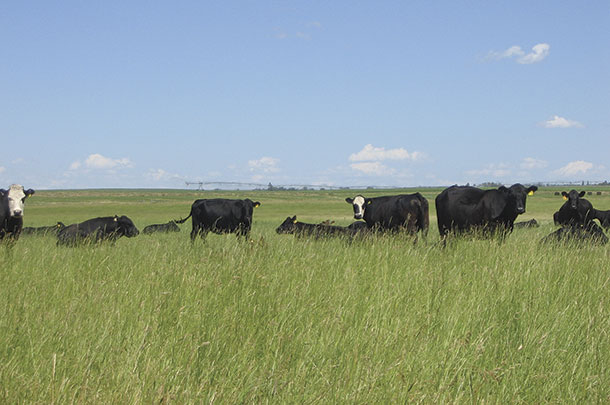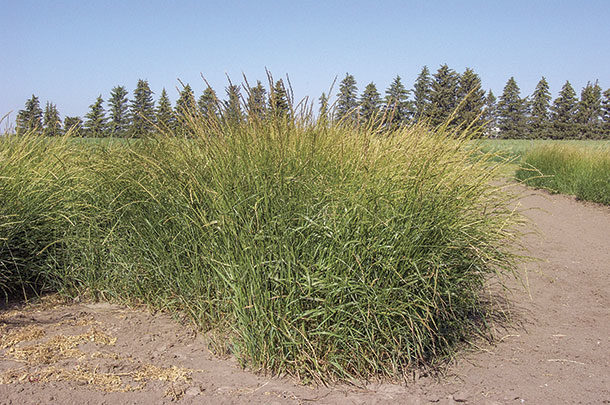Salinity is a major soil degradation problem throughout the world and results in considerable economic losses to the agricultural sector. In North America, it is estimated between 5 to 16 million hectares (12.4 million to 39.5 million acres) are suffering from soil salinization, and it is still increasing annually.
These nonproductive areas are often ignored and unmanaged because rehabilitation is difficult and costly, thus leaving opportunities for invasion by weedy species, especially foxtail barley.
Foxtail barley (Hordeum jubatum L.), a native, high-salinity-tolerant, short-lived perennial bunchgrass, adversely alters the usefulness and productivity of many croplands and creates a hazard for grazing cattle. One exciting and practical solution is the use of AC Saltlander green wheatgrass (Elymus hoffmannii Jensen & Asay, or ACS) as a forage to suppress foxtail barley and deplete excess near-surface profile of water, thus reducing salinization potential.
AC Saltlander green wheatgrass, a perennial cool-season grass, was developed in 2004 by Harold Steppuhn, a soil salinity researcher (retired) at Agriculture and Agri-Food Canada – Swift Current Research and Development Centre (AAFC-SCRDC), to tolerate moderate to severe root-zone salinity with good forage productivity, palatability and nutritional qualities.
It has been commercially available in Canada since 2008 (Nutrien Ag Solutions) and more recently in the U.S. (Big Sky Wholesale Seeds Ltd.). The extensive creeping root system of ACS can help lower the shallow water table to prevent salt from accumulating near the soil surface. This characteristic makes it an ideal choice for managing saline soils where other agronomic and engineering solutions are inefficient and too costly.
 AC Saltlander green wheatgrass, a perennial cool-season grass, is shown in a grazed pasture application. Photos provided by Alan Iwaasa.
AC Saltlander green wheatgrass, a perennial cool-season grass, is shown in a grazed pasture application. Photos provided by Alan Iwaasa.
A major limitation to the use of ACS is its high seed cost, since seed yields are low. In the last five years in Canada, ACS seed costs have increased over 40 percent for certified seed. As a result of this, research was conducted to evaluate what is the best ACS seeding rate on moderate to severe saline soils.
Seeding rate is an important management factor affecting agriculture production. Higher seeding rate inevitably increases production costs, whereas lower seeding rate probably increases the risks of reducing production.
Manipulation in seeding rate is also an effective tactic to suppress weeds and reduce herbicide uses. Thus, the study was also interested in the effects of ACS seeding rates on foxtail barley suppression.
The ACS seeding rate study was conducted from 2013 to 2015 on dryland characterized as severe to very severe range of soil salinity at AAFC-SCRDC. The environmental conditions experienced during the study period were normal and above long-term annual precipitations in 2013 and 2014, respectively, while in 2015 the spring period was very dry and below long-term annual precipitation.
Each of the four seeding rates (2.8, 5.6, 11.2 and 16.8 kilograms ha-1 pure live seed or 2.5, 5, 10 and 15 pounds per acre) were replicated four times. The ACS was seeded on June 16, 2011, using a disc-drill with 30.5-centimeter row spacing after glyphosate was applied and the land was cultivated and harrow-packed.
The study results showed seeding rates between 5.6 and 11.2 kilograms ha-1 (5 and 10 pounds per acre) had similar forage yields to the 16.8-kilogram ha-1 (15-pound-per-acre) seeding rate and better foxtail barley weed suppression compared to the lowest seeding rate. The foxtail barley relative yield was the highest, and ACS relative yield was the lowest for the 2.8-kilogram ha1 (2.5-pound-per-acre) seeding rate.
In support, Steppuhn also observed ACS was effective in suppressing foxtail barley in slight to moderate saline conditions. Although the 5.6- and 11.2-kilogram ha-1 (5- and 10-pound-per-acre) seeding rates responded similarly, it is recognized that at high salinity ranges and challenging environments, this could justify recommending the higher ACS seeding rate to achieve better forage establishment, biomass production and foxtail barley weed suppression.
Two other research studies involve ACS at AAFC-SCRDC. The first study is researching the effects of waterlogging or salinity alone and combination of both on AC Saltlander green wheatgrass and smooth brome forage production.
This study is completed and evaluated the effects of three waterlogging treatments (no waterlogging, three and five weeks continuous waterlogging) on two forages (ACS and smooth bromegrass [Bromus inermis] under two water solutions [nonsalinity and moderate salinity]). Preliminary conclusions found ACS grass is better than smooth bromegrass to tolerate either waterlogging or moderate salinity alone or a combination of both.
The second study is about developing best management practices for cost-effective and successful establishment of saline forages for Saskatchewan and is still in progress. In this study, different ACS seeding rates (5.6 and 11.2 kilograms ha-1 or 5 and 10 pounds per acre), seeding times (spring and fall) and methodologies (conventional or direct seeding) on two different salinity ranges (slight to moderate and moderate to severe) are being evaluated to determine the optimum management practice for ACS establishment under dryland conditions.
This study is in its third year of a five-year study, and the ACS has successfully established on the slight to moderate salinity ranges while, on the moderate to severe salinity range, the ACS establishment is mixed. Considering the very dry conditions experienced in 2017 and 2018, and the heavy weed competition, the ACS establishment is still very impressive.
Research has shown the opportunity exists to seed ACS to help contain saline areas and suppress foxtail barley on pasture, hay or cropland. Successful establishment of ACS to reclaim or convert unproductive saline land to a productive hay or pasture resource would have a huge economic benefit to North America. In addition, ACS is also able to suppress foxtail barley weed concerns and provide an environmental benefit against the spread of invasive weeds on and into croplands and pastures.








